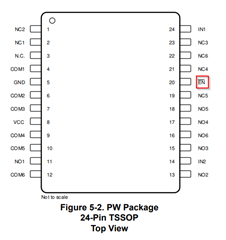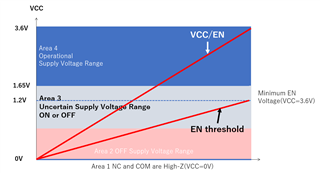Other Parts Discussed in Thread: TS3A27518
Tool/software:
Dear Specialists,
My customer is considering TS3A27518E and has a question.
I would be grateful if you could advise.
---
Since the pull-up power supply for the SD card signal line comes up before the SD card's VDD, I am considering using the TS3A27518E as a solution.
At this time, I want to eliminate false ON of NC, NO, and COM when the power supply (Vcc) is turned on.
According to the datasheet,
① The input pin ratings of the TS3A27518E are specified in 6.1 Absolute Maximum Rating on p. 5 of the data sheet.
VNC, VNO, and VCOM are specified as voltage values, but they also apply when the power supply is turned off.
There is no risk of damage if they are within the range of -0.5 to 4.6V when the power supply is turned off.
② Figure 6-6. Control Input Thresholds (IN1, TA = 25°C) on p. 12 of the data sheet shows a graph of control voltage and output characteristics.
Although this is a graph of IN1, IN1, IN2, and /EN are specified with the same characteristics in the electrical characteristics, so they can be considered to be the same.
When V+ = 1.65V, it can be confirmed that the output voltage changes from around 0.53V when the control voltage is 0.53V.
The EN threshold is between VIL and VIH, which is significantly lower than 1.65V,
so it is possible that NC, NO, and COM may be turned on.
Based on ① and ②,
I think that if EN is connected to a power supply of 1.2V or higher and power is turned on at Vcc, there is no possibility that NC, NO, or COM will be turned ON.
Is this understanding correct?
If you have any other solution to Eliminate false ON of NC, NO, and COM when starting up the power supply (Vcc), could you advise?
ーーー
I appreciate your great help in advance.
Best regards,
Shinichi











